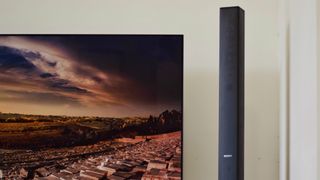TechRadar Verdict
Sony is known for their perfection when it comes to imaging. Their superlative picture processing aids the A8F to deliver impressively pure, clean picture, stunning black levels, and intense contrast and colors. Also, its svelte design melts with the aesthetics of the room quite effortlessly. But for all that, you need to pay way more than many basic 4K TVs in the market.
Pros
- +
Outstanding picture processing
- +
Clever, effective audio system
- +
Gorgeous black levels
- +
Well-designed picture presets
- +
Great design
Cons
- -
Lacks brightness with HDR
- -
Unpleasant remote control
- -
Expensive
Why you can trust TechRadar
When Sony launched their flagship A1 TVs in 2017, cinema fans embraced the combination of Sony processing and OLED technology. The only downside faced by the TV was it’s design, which some complained wasn’t angled for best viewing experience and couldn’t be hung on a wall.
However, this year, Sony has revisited the flaws and has brought a totally new intuitive design without any compromise to the picture quality. The latest among the league is the A8F, which is a more straightforwardly-designed 4K OLED TV. It’s the flagship product from Sony and so is the price, it retails at Rs 3,29,900 for the 55-inch variant and 4,49,900 for the bigger 65-inch variant.
Design

We reviewed the 55-inch variant of the Sony A8F OLED TV, which was easy to accommodate in a typical living room compared to the A1-series. It gets a minimalistic and sturdy table stand that sticks firmly in the center of the panel, and hides itself completely behind the TV. It was really easy to fix and the TV holds the surface quite firmly. It sits easily on any bit of furniture, and can also be mounted on a wall unlike the A1.
Sony’s attention to detail is visible in the design. For instance, its ultra-narrow neck-free stand that we mentioned is so discrete that it minimises the visual impact of any other hardware, which actually helps you focus only on the content you are watching.
Most importantly of all, there are no other visible speakers. The TV uses Sony’s ‘acoustic surface’ technology, which uses actuators affixed to the back of the panel to turn the entire screen into a sound-emitting structure.

The TV is ultra thin, well-built and small details like a detachable cover for ports and a very subtle LED light at the bottom edge make you feel good about your investment.
While the TV is robust and beautiful, its remote isn't the same. It's huge and sturdy, but it doesn't justify the feel that the TV offers.

Screen sizes available: 65-inch, 55-inch | Tuner: Freeview HD | 4K: Yes | HDR: Yes (HDR10, Dolby Vision (following a future update), HLG) | Panel technology: OLED | Smart TV: Yes/Android TV 7.0 | Curved: No | Dimensions: 1226(w) x 712(h) x 55(d) mm | 3D: No | Inputs: 4 HDMIs, three USBs, RF tuner
Smart TV Features
To start with, the first thing I look for in a Smart TV is the support 4K HDR versions of Netflix, Amazon and YouTube. Apart from that, you get a host of Sony apps and a Google Play Store for apps you would like to have on your the TV.
Perhaps the best thing to come from the integrated Android TV platform is built-in Chromecast support, for easier sharing of content on your mobile devices. There’s also support for Google Assistant and Alexa voice control.
If there’s an issue, then it’s the Android TV platform. The major problem in the platform is that it eventually slows down, lags and sometimes crashes. Moreover, Android’s recommendation system still needs to improve its judgement for preferences and behaviour.
Sony claims that the AF8s will be upgraded to receive Android 8, which is expected to usher in a very different interface. Let’s hope that this finally solves at least some of Android TV’s long-running issues.
HD/SDR Performance

We’re not doubtful while saying that the Sony A8F is one of the best TVs with standard dynamic range, HD-resolution content. More so, because of the phenomenal prowess behind the X1 Extreme processing engine. It transforms the grubbiest HD sources into something that looks clean, polished and resembles 4K more than it resembles HD. Even messy HD sources look cleaner and more watchable than they tend to even on good native HD TVs.
The TV also applies SDR to HDR conversion to most of its picture presets. The HDR up conversion is impressive, as it opens up the SDR picture’s colour and brightness almost 50% of the HDR feels without hampering the picture quality.
There are other competitive TVs that provide more aggressive HDR conversion of SDR content, I still prefer Sony’s balanced approach and consistency.
Upon choosing a preset, you can watch SDR content in its native colour and brightness values. Where the A8F again excels with the way it handles detail, colour, light and shade.
4K/HDR Performance

In usual cases, it’s the processing prowess and beautiful colour management that makes the A8F so good with HD/SDR content and a sublime 4K/HDR performer. It does a great job at suppressing the picture noise.
There’s no fizzing and colour blocking, ranging from highly saturated scenes to subtly toned content. On top of everything, there’s no trace of striping noise in subtle 4K HDR color blends, and there’s minimal to no sign of vertical brightness banding issue found on most OLED panels.
The A8F have rich black levels and lack of noise makes them arguably the deepest and purest black levels. Also, it helps deliver high contrast HDR images with a perfect level of intensity. All of this makes it a perfect television for home cinema fanatics.
With almost no greys on the panel, the colours produced on the display are rich and authentic aided by Sony Triluminos color processing platform.
Sony’s exemplary processing works wonders, too, with the A8F’s motion performance. Using the Standard or True Cinema settings of the MotionFlow system sees judder reduced without the picture becoming so fluid that it no longer looks natural. Even better, this impressively natural reduction in judder is achieved without generating shimmering side effects around the edges of moving objects; flickering over really fast movement; or the sudden stutters or ‘billowing’ issues seen with some rival OLED TVs.

Sound performance
One of the most impressive technology by Sony in recent years is their ‘Acoustic Surface’ audio solution for TVs. It is extremely impressive, even more than many soundbars you would find in the market.
The sound is open, well-rounded and detailed. The screen plays directional sound effects on point. For instance, while watching Avengers: Infinity Wars, I could clearly hear the blasts and thunders from different parts of the screen. Similarly, movement of vehicles, spaceships or missiles crossing the screen have an uncanny accuracy.
The loudness, thump and impact of the audio is very impressive, and it further topped with the woofer speaker on the rear that produces passable amount of bass.
Verdict
If you were impressed by the Sony A1, but wanted a refined version of the TV with more features, the A8F is for you. Among the few OLED TVs, the A8F is not the best by latest standards, but it's still a great option to consider.
Sony's X1 Extreme engine provides exemplary processing power that helps it to achieve amazing black level performance and beautifully refined color processing. The 4K content looks incredible, and its motion handling and high levels of refinement are also among the best available.
However, it's sad that the A8F only finds the same limited amount of brightness for its HDR playback that Sony’s A1 OLED debutantes did.
Sudhanshu Singh have been working in tech journalism as a reporter, writer, editor, and reviewer for over 5 years. He has reviewed hundreds of products ranging across categories and have also written opinions, guides, feature articles, news, and analysis. Ditching the norm of armchair journalism in tech media, Sudhanshu dug deep into how emerging products and services affect actual users, and what marks they leave on our cultural landscape.
His areas of expertise along with writing and editing include content strategy, daily operations, product and team management.


